Now indoor plants, including begonia, are in great demand and popularity. It can often be found at flower growers as a decorative decoration at home, especially during its flowering. A little knowledge and sufficient attention will certainly bear fruit and the plant will please its owner with multi-colored inflorescences for a long period.
Material Content:
Species and varieties
Begonia belongs to the genus Begoniaceae, which has more than 800 varieties of plants. The begonia is home to the tropics and subtropics of Asia and Africa.
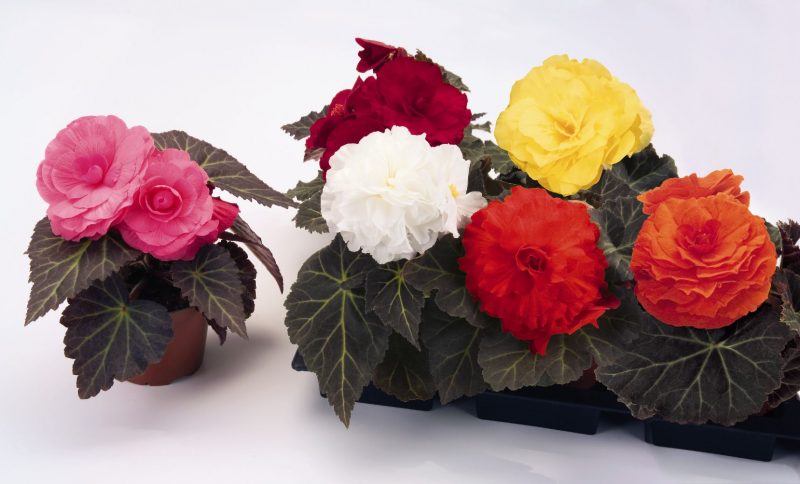
All types of this indoor flower can be divided into 2 large groups: flowering and deciduous varieties. A distinctive feature of the latter are colorful leaves of various shapes. Among the flowering plants, there are such popular varieties in home floriculture:
- Tuberous begonia. The plant variety is distinguished by a variety of inflorescences. Petals can be of different colors, ranging from white tones to dark red. Inflorescences come in two colors at the same time and reach a diameter of 5 to 15 cm. Terry-looking flowers are very similar to roses and peonies.
- Begonia ever flowering. The everlasting flower variety is the most common, can be grown both on flower beds and indoors. In apartments, this variety can produce inflorescences throughout the year. They are collected from small flowers of red, pink or white.
- Royal begonia. It is different and appreciated for the beauty of the leaves.They can be of different colors and reach a length of up to 40 cm. At the same time, foliage can take several shades, and even with a fringing of a different color along the edge.
Begonia - the nuances of growing
In the first days after buying a plant, you need to pay more attention to it, so that it decorates the house and has a healthy appearance for several years.

To grow begonias at home, you should adhere to some rules and nuances:
- Create favorable conditions for active flower growth.
- Try to protect him from drafts and wind.
- Provide optimal environmental parameters in the winter.
- Try to pick a flower suitable place so as not to disturb him.
Important! It is not recommended to purchase begonia and transplant it in the winter. She may not take root and die during a transplant from a transport pot.
Begonia care at home
Home care for begonias is not too complicated and consists in maintaining a comfortable temperature, sufficient light and humidity. In order for a plant to feel comfortable at home, it is necessary to create conditions close to natural conditions for it.
Optimal conditions
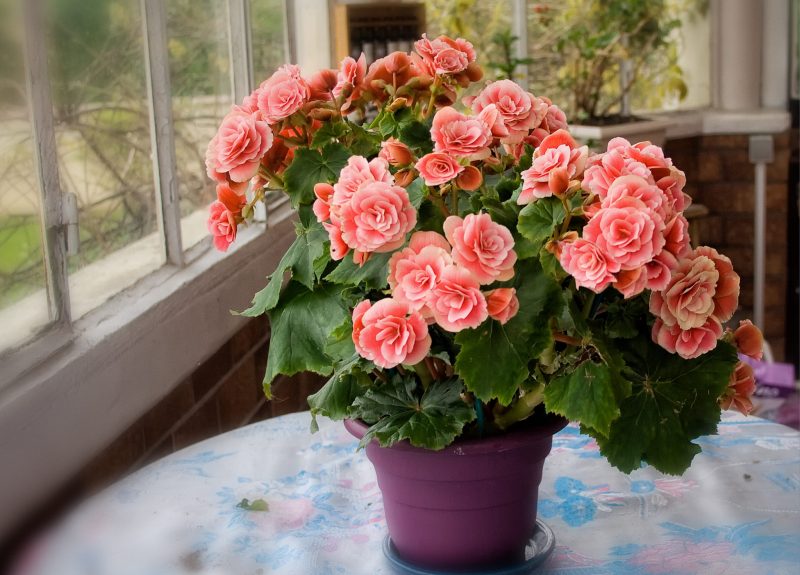
- Shine. The plant needs to be settled on a windowsill with plenty of light. But it is worth protecting it from direct sunlight, especially during flowering, otherwise a burn will form on the leaves. To avoid this, you need to create some shading using curtains or blinds.
- Day length. A decoratively growing flower needs daylight hours of up to 12-14 hours. In autumn and winter, he needs to organize additional lighting with the help of special lamps.
- Temperature. The optimal indicator is 15-22 degrees. In winter, a favorable temperature will be 19 degrees. Strong temperature extremes and lowering below 14 degrees must not be allowed, otherwise the plant may discard foliage or die.
- Humidity. It is necessary to organize this indicator at the level of 80 percent. To increase it, you can put a container filled with water next to the pot. Or you can even put a cache-pot with a plant on the aquarium.
Important! You can not irrigate and spray the crown of the plant, otherwise spots will appear on the leaves.
Watering and dressing a flower
Watering the plant is necessary as the earthen coma dries.
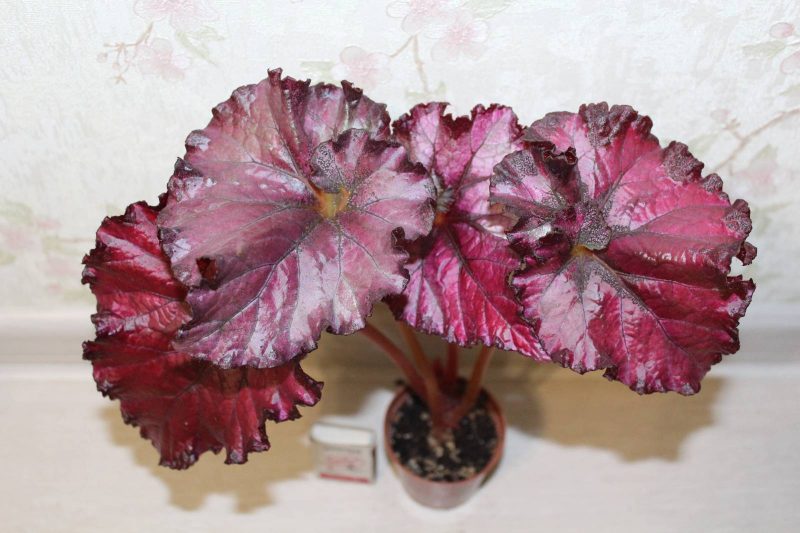
- In the hot summer months, watering should be done daily.
- It is impossible to overmoisten the soil so that the roots do not rot. Tuber begonia is most often exposed to rot.
- In autumn and winter, watering should be reduced to 1-2 times a week.
- It should be remembered that begonia has its own requirements for water - it must be clean, previously settled and at room temperature.
- During watering, water should not be allowed to fall on the leaves.
Top dressing must begin during the formation of inflorescences. For this, liquid complex fertilizers are suitable. They are introduced with water during irrigation. Begonia should be fed 2 times a month in spring and summer. In winter, the plant does not need fertilizers.
How to care for begonias in winter?
In winter, many plants fall into a dormant period, including a begonia flower.

To save it in the winter and create suitable conditions, you must follow these rules:
- Equip additional lighting to provide daylight hours up to 14-15 hours. With a lack of light, the stems of the plant stretch.
- Ensure optimal temperature conditions (18-19 degrees) and prevent the temperature from falling below 16 degrees.
- Reduce watering to 1 time per week.
- Do not place a pot of plants near radiators.
- For tuber begonia in winter, reduce moisture so that its tubers do not rot.
- When yellowed leaves appear, you need to inspect the plant and remove the affected dry parts.
If all the rules for caring for a houseplant are observed in the winter, with the onset of the spring period, begonia will delight the owner with its flowering, which will last until the very end of summer.
Houseplant transplant
It is necessary to transplant the plant as the pot of the root system is filled. Begonia does not have a special requirement for soil. You can buy ready-made soil or cook it yourself. To do this, mix in equal parts sheet land, sand, peat and humus.
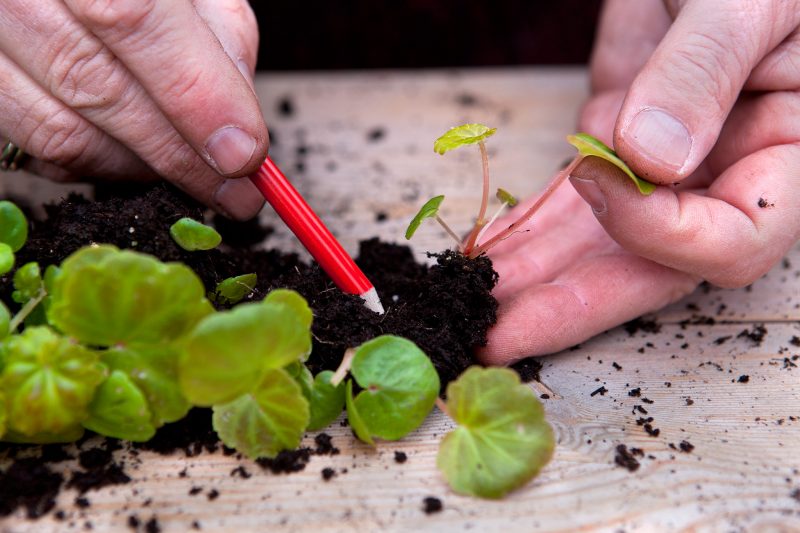
- The pot must be selected larger than the previous one by 3-4 cm in diameter. At the bottom, it is necessary to organize good drainage so that moisture does not accumulate there and the roots do not rot.
- It is better to transplant with the advent of spring. The frequency of transplants is once every 2-3 years.
- Before the procedure, the flower should be shed well, so that it is easier to remove it from the ground.
- From the roots, you need to remove excess earth and remove damaged parts.
- To prevent diseases of the root system, you can place the plant in a weak solution of potassium permanganate for 30 minutes.
- In a new container, you need to carefully place the plant without damaging the roots. Sprinkle lightly with earth and compact it.
The first month after a begonia transplant, more attention needs to be paid. Provide more light, plentiful daily watering and a temperature of 22-23 degrees. It is advisable to observe special conditions until the plant has taken root and begins to grow actively.
Begonia breeding
Like many plants, begonia (begonia) can multiply in different ways. It is best to engage in reproduction in the spring or in the summer, during the active growth of the flower.
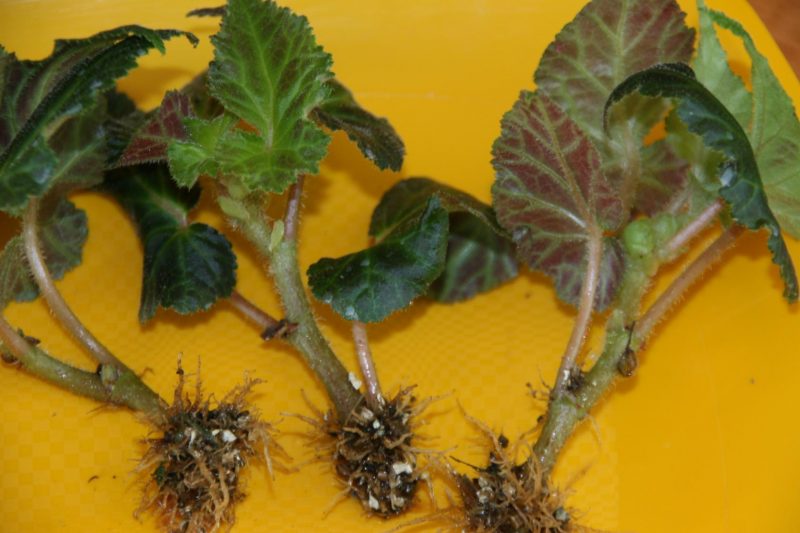
The main methods of propagation of begonia:
- stem cuttings;
- seeds;
- sheet division;
- rhizome division;
- division of tubers.
Cuttings are suitable for all types of begonias and are the easiest and most convenient way of propagation.
To do this, follow these steps:
- Cut the cuttings with a sharp knife 10 cm long so that each contains 2-3 leaflets.
- You can place the workpiece in clean, defended water until the formation of roots. After, they are planted in a pot prepared with soil.
- It is allowed to plant the stalk immediately in a container with soil. Then from above it is necessary to cover it with polyethylene.
- After new leaflets appear, the bag is removed and the stalk is transplanted to a permanent place.
The method of propagation by dividing the sheet is suitable if you want to get more planting material.
- To do this, with a sharp knife, a large sheet is cut into several parts so that each has a central vein.
- After dividing, the parts should be placed in a box on top of the soil, slightly pressed down. You can deepen them a little into the ground.
- On top of the box is covered with film or glass. Daily airing is carried out.
- When the seedlings take root, they are transplanted to a permanent place.
The seed method is more troublesome. Sowing must begin in early February, so that the seedlings have time to grow and grow stronger by the winter period.
- First, prepare boxes with soil, on the surface of which seeds are evenly distributed.
- On top of them sprinkle with a thin layer (about 0.2 cm) of the earth.
- Boxes are covered with film or glass.
- Every day you should moisten the soil from the spray, so as not to "wash" the seeds, as well as ventilate them.
- When shoots appear, the film must be removed.
To propagate the flower by dividing the rhizome, it is necessary to take it out of the ground, divide the roots into several parts with a sharp knife and plant them in containers prepared with the ground. And for tuberous species of begonias, a method of propagation by division of tubers is suitable.It begins with the onset of spring. The tuber must be cut into several parts so that each has 1 kidney. Sliced tubers are planted in separate pots.
Pest and Disease Control
In indoor conditions, like many plants, begonia can be exposed to diseases and pests.
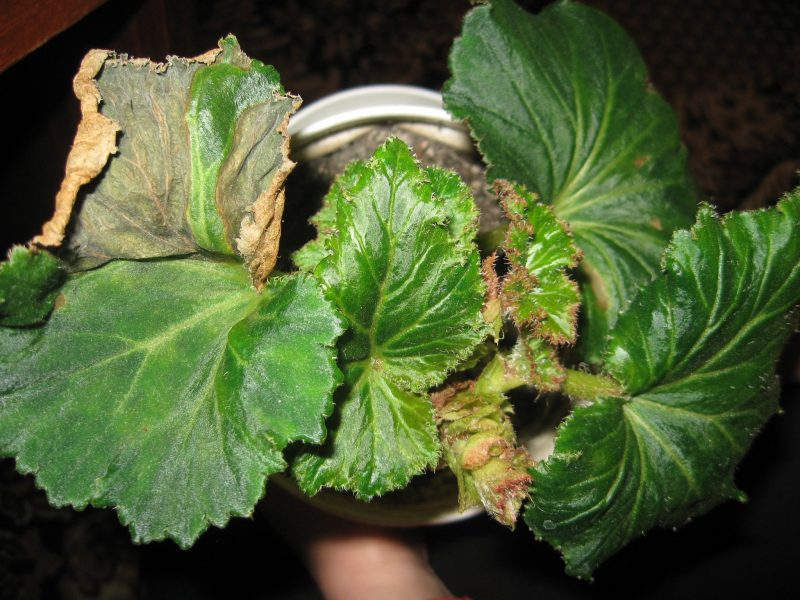
The most common diseases are:
- gray mold;
- powdery mildew;
- root rot.
In the fight against diseases, it is necessary to treat the plant with fungicides, reduce moisture and reduce the amount of watering.
The main pests include:
- whitefly;
- false shields;
- spider mite;
- aphids;
- nematodes;
- thrips.
When insect pests appear on the bush, it is necessary to treat it with insecticides and remove all affected parts. Otherwise, you will have to get rid of the flower so that pests do not populate healthy plants.
The main problems when growing
When growing begonia in room conditions, some problems may arise if you do not follow the agrotechnical requirements for caring for it.
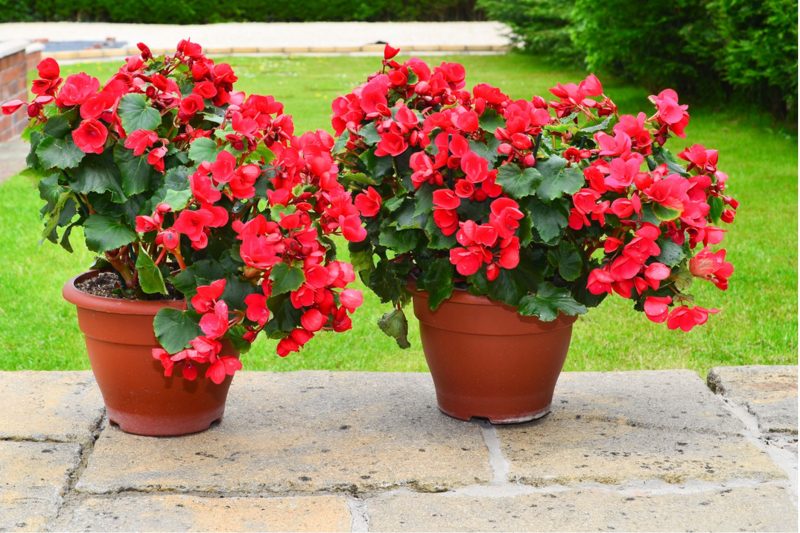
- Rotting of roots and stems occurs due to frequent watering.
- If the foliage falls in the winter, then the room has a reduced temperature.
- Does evergreen begonia cease to bloom, slow growth? This indicates insufficient nutrition with nutrients.
- Dry and sluggish leaves indicate dry air and insufficient humidity.
- Leaves become yellow if there is not enough watering and the temperature in the room is low.
In order not to have problems with the cultivation of the discussed indoor flower, you need to give him a little time and care. Then he will delight the whole year with his flowering and multi-colored colors of inflorescences and leaves. At the slightest appearance of pests, it is necessary to act urgently so that the plant does not die.












